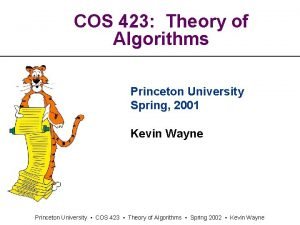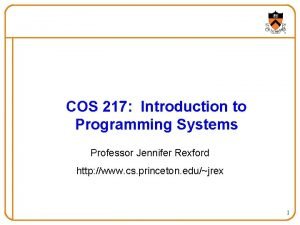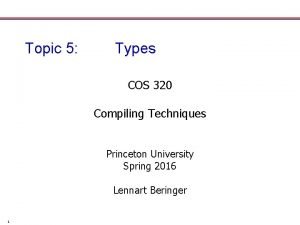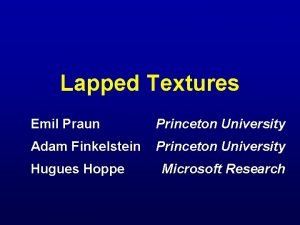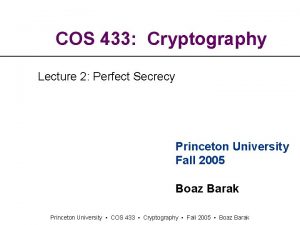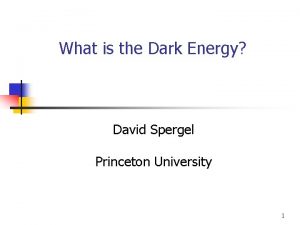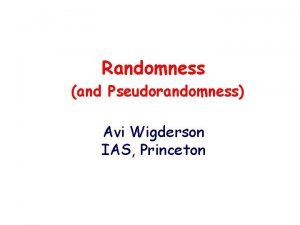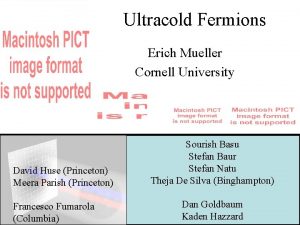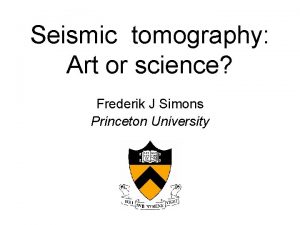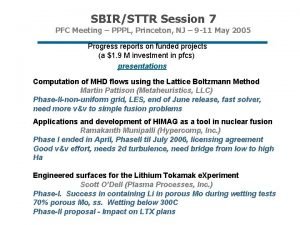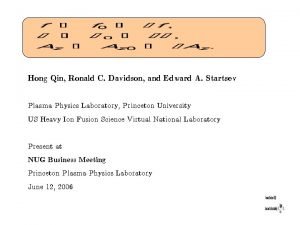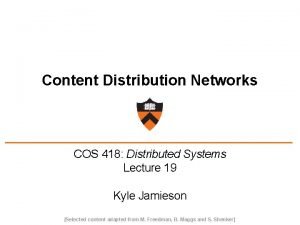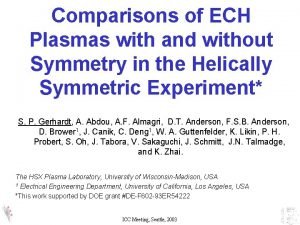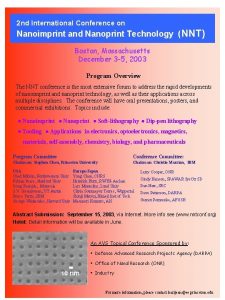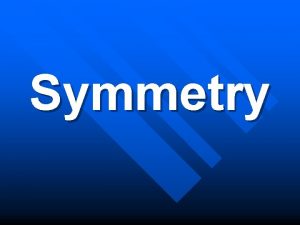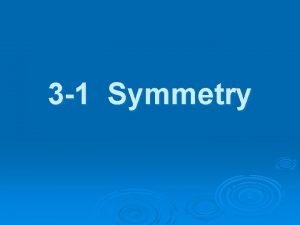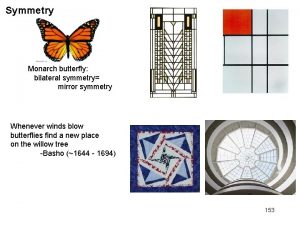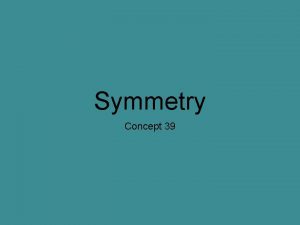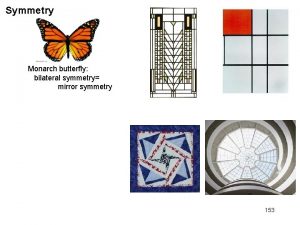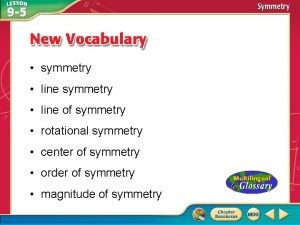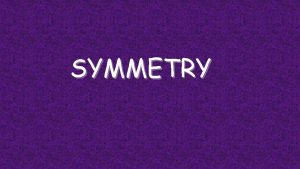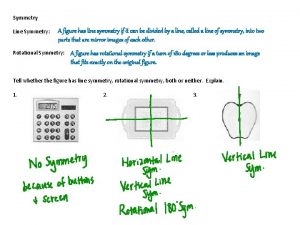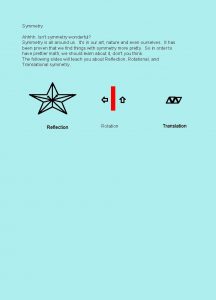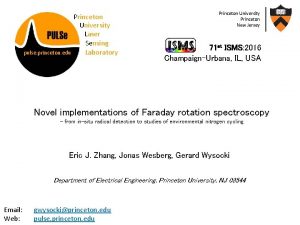The PlanarReflective Symmetry Transform Princeton University Motivation Symmetry


![Motivation Symmetry is everywhere Perfect Symmetry [Blum ’ 64, ’ 67] [Wolter ’ 85] Motivation Symmetry is everywhere Perfect Symmetry [Blum ’ 64, ’ 67] [Wolter ’ 85]](https://slidetodoc.com/presentation_image_h/9b8c9f7ae47aeb42a625fe65e14ecd77/image-3.jpg)
![Motivation Symmetry is everywhere Local Symmetry [Blum ’ 78] [Mitra ’ 06] [Simari ’ Motivation Symmetry is everywhere Local Symmetry [Blum ’ 78] [Mitra ’ 06] [Simari ’](https://slidetodoc.com/presentation_image_h/9b8c9f7ae47aeb42a625fe65e14ecd77/image-4.jpg)
![Motivation Symmetry is everywhere Partial Symmetry [Zabrodsky ’ 95] [Kazhdan ’ 03] Motivation Symmetry is everywhere Partial Symmetry [Zabrodsky ’ 95] [Kazhdan ’ 03]](https://slidetodoc.com/presentation_image_h/9b8c9f7ae47aeb42a625fe65e14ecd77/image-5.jpg)












































![Application: Segmentation Motivation: • Modeling by parts [Chazelle ’ 95][Li ’ 01] [Mangan ’ Application: Segmentation Motivation: • Modeling by parts [Chazelle ’ 95][Li ’ 01] [Mangan ’](https://slidetodoc.com/presentation_image_h/9b8c9f7ae47aeb42a625fe65e14ecd77/image-50.jpg)







![Application: Viewpoint Selection Motivation: • Catalog generation • Image Based Rendering [Blanz ’ 99][Vasquez Application: Viewpoint Selection Motivation: • Catalog generation • Image Based Rendering [Blanz ’ 99][Vasquez](https://slidetodoc.com/presentation_image_h/9b8c9f7ae47aeb42a625fe65e14ecd77/image-58.jpg)







- Slides: 65

The Planar-Reflective Symmetry Transform Princeton University

Motivation Symmetry is everywhere
![Motivation Symmetry is everywhere Perfect Symmetry Blum 64 67 Wolter 85 Motivation Symmetry is everywhere Perfect Symmetry [Blum ’ 64, ’ 67] [Wolter ’ 85]](https://slidetodoc.com/presentation_image_h/9b8c9f7ae47aeb42a625fe65e14ecd77/image-3.jpg)
Motivation Symmetry is everywhere Perfect Symmetry [Blum ’ 64, ’ 67] [Wolter ’ 85] [Minovic ’ 97] [Martinet ’ 05]
![Motivation Symmetry is everywhere Local Symmetry Blum 78 Mitra 06 Simari Motivation Symmetry is everywhere Local Symmetry [Blum ’ 78] [Mitra ’ 06] [Simari ’](https://slidetodoc.com/presentation_image_h/9b8c9f7ae47aeb42a625fe65e14ecd77/image-4.jpg)
Motivation Symmetry is everywhere Local Symmetry [Blum ’ 78] [Mitra ’ 06] [Simari ’ 06]
![Motivation Symmetry is everywhere Partial Symmetry Zabrodsky 95 Kazhdan 03 Motivation Symmetry is everywhere Partial Symmetry [Zabrodsky ’ 95] [Kazhdan ’ 03]](https://slidetodoc.com/presentation_image_h/9b8c9f7ae47aeb42a625fe65e14ecd77/image-5.jpg)
Motivation Symmetry is everywhere Partial Symmetry [Zabrodsky ’ 95] [Kazhdan ’ 03]

Goal A computational representation that describes all planar symmetries of a shape ? Input Model

Symmetry Transform A computational representation that describes all planar symmetries of a shape ? Input Model Symmetry Transform

Symmetry Transform A computational representation that describes all planar symmetries of a shape ? Perfect Symmetry = 1. 0

Symmetry Transform A computational representation that describes all planar symmetries of a shape ? Zero Symmetry = 0. 0

Symmetry Transform A computational representation that describes all planar symmetries of a shape ? Local Symmetry = 0. 3

Symmetry Transform A computational representation that describes all planar symmetries of a shape ? Partial Symmetry = 0. 2

Symmetry Measure Symmetry of a shape is measured by correlation with its reflection

Symmetry Measure Symmetry of a shape is measured by correlation with its reflection Symmetry = 0. 7

Symmetry Measure Symmetry of a shape is measured by correlation with its reflection Symmetry = 0. 3

Outline • Introduction • Algorithm – Computing Discrete Transform – Finding Local Maxima Precisely • Applications – Alignment – Matching – Segmentation – Viewpoint Selection • Summary

PRST

Outline • Introduction • Algorithm – Computing Discrete Transform – Finding Local Maxima Precisely • Applications – Alignment – Segmentation • Summary – Matching – Viewpoint Selection

Computing Discrete Transform n planes • Brute Force • Convolution • Monte-Carlo

Computing Discrete Transform O(n 3) planes X = O(n 6) O(n 3) dot product O(n 6) n planes • Brute Force • Convolution • Monte-Carlo

Computing Discrete Transform O(n 6) O(n 5 Log n) n planes • Brute Force • Convolution • Monte-Carlo

Computing Discrete Transform • Brute Force • Convolution • Monte-Carlo O(n 6) O(n 5 Log n) O(n 4) For 3 D meshes – Most of the dot product contains zeros. – Use Monte-Carlo Importance Sampling.

Offset Monte Carlo Algorithm Angle Input Model Symmetry Transform

Monte Carlo Algorithm Offset Monte Carlo sample for single plane Angle Input Model Symmetry Transform

Offset Monte Carlo Algorithm Angle Input Model Symmetry Transform

Offset Monte Carlo Algorithm Angle Input Model Symmetry Transform

Offset Monte Carlo Algorithm Angle Input Model Symmetry Transform

Offset Monte Carlo Algorithm Angle Input Model Symmetry Transform

Offset Monte Carlo Algorithm Angle Input Model Symmetry Transform

Weighting Samples Need to weight sample pairs by the inverse of the distance between them P 2 d P 1

Weighting Samples Need to weight sample pairs by the inverse of the distance between them Two planes of (equal) perfect symmetry

Weighting Samples Need to weight sample pairs by the inverse of the distance between them Votes for vertical plane…

Weighting Samples Need to weight sample pairs by the inverse of the distance between them Votes for horizontal plane.

Outline • Introduction • Algorithm – Computing Discrete Transform – Finding Local Maxima Precisely • Applications – Alignment – Segmentation • Summary – Matching – Viewpoint Selection

Finding Local Maxima Precisely Motivation: • Significant symmetries will be local maxima of the transform: the Principal Symmetries of the model Principal Symmetries

Finding Local Maxima Precisely Approach: • Start from local maxima of discrete transform • Finding the candidate plane by using threshold(1 -r/R)

Finding Local Maxima Precisely Approach: • Start from local maxima of discrete transform • Refine iteratively to find local maxima precisely ………. Initial Guess Final Result

Outline • Introduction • Algorithm – Computing discrete transform – Finding Local Maxima Precisely • Applications – Alignment – Segmentation • Summary – Matching – Viewpoint Selection

Application: Alignment Motivation: • Composition of range scans • Feature mapping PCA Alignment

Application: Alignment Approach: • Perpendicular planes with the greatest symmetries create a symmetry-based coordinate system.

Application: Alignment Approach: • Perpendicular planes with the greatest symmetries create a symmetry-based coordinate system.

Application: Alignment Approach: • Perpendicular planes with the greatest symmetries create a symmetry-based coordinate system.

Application: Alignment Approach: • Perpendicular planes with the greatest symmetries create a symmetry-based coordinate system.

Application: Alignment Results: PCA Alignment Symmetry Alignment

Application: Matching Motivation: • Database searching = Query Database Best Match

Application: Matching Observation: • All chairs display similar principal symmetries

Application: Matching Approach: • Use Symmetry transform as shape descriptor = Query Transform Database Best Match

Application: Matching Results: • The PRST provides orthogonal information about models and can therefore be combined with other shape descriptors

Application: Matching Results: • The PRST provides orthogonal information about models and can therefore be combined with other shape descriptors

Application: Matching Results: • The PRST provides orthogonal information about models and can therefore be combined with other shape descriptors
![Application Segmentation Motivation Modeling by parts Chazelle 95Li 01 Mangan Application: Segmentation Motivation: • Modeling by parts [Chazelle ’ 95][Li ’ 01] [Mangan ’](https://slidetodoc.com/presentation_image_h/9b8c9f7ae47aeb42a625fe65e14ecd77/image-50.jpg)
Application: Segmentation Motivation: • Modeling by parts [Chazelle ’ 95][Li ’ 01] [Mangan ’ 99][Garland ’ 01] [Katz ’ 03]

Application: Segmentation Observation: • Components will have strong local symmetries not shared by other components

Application: Segmentation Observation: • Components will have strong local symmetries not shared by other components

Application: Segmentation Observation: • Components will have strong local symmetries not shared by other components

Application: Segmentation Observation: • Components will have strong local symmetries not shared by other components

Application: Segmentation Observation: • Components will have strong local symmetries not shared by other components

Application: Segmentation Approach: • Cluster points on the surface by how well they support different symmetries …. . Support = 0. 1 Support = 0. 5 Support = 0. 9 Symmetry Vector = { 0. 1 , 0. 5 , …. , 0. 9 }

Application: Segmentation Results:
![Application Viewpoint Selection Motivation Catalog generation Image Based Rendering Blanz 99Vasquez Application: Viewpoint Selection Motivation: • Catalog generation • Image Based Rendering [Blanz ’ 99][Vasquez](https://slidetodoc.com/presentation_image_h/9b8c9f7ae47aeb42a625fe65e14ecd77/image-58.jpg)
Application: Viewpoint Selection Motivation: • Catalog generation • Image Based Rendering [Blanz ’ 99][Vasquez ’ 01] [Lee ’ 05][Abbasi ’ 00] Picture from Blanz et al. ‘ 99

Application: Viewpoint Selection Approach: • Symmetry represents redundancy in information.

Application: Viewpoint Selection Approach: • Symmetry represents redundancy in information • Minimize the amount of visible symmetry • Every plane of symmetry votes for a viewing direction perpendicular to it Best Viewing Directions

Application: Viewpoint Selection Results: Viewpoint Function

Application: Viewpoint Selection Results: Viewpoint Function Best Viewpoint

Application: Viewpoint Selection Results: Viewpoint Function Best Viewpoint Worst Viewpoint

Application: Viewpoint Selection Results:

The End
 Princeton university’s gerrymandering project
Princeton university’s gerrymandering project Pics princeton
Pics princeton Princeton cos 316
Princeton cos 316 Princeton iac
Princeton iac Hantao ji
Hantao ji Cos 423 princeton
Cos 423 princeton Cos423
Cos423 Cos 217
Cos 217 Cos 320
Cos 320 Quasicrystals ppt
Quasicrystals ppt Eric larson princeton
Eric larson princeton Roberto car princeton
Roberto car princeton Princeton policy task force
Princeton policy task force Cos
Cos Citp princeton
Citp princeton Cmr china
Cmr china Adam finkelstein princeton
Adam finkelstein princeton Kirk mcdonald princeton
Kirk mcdonald princeton Cos318 fall 2021
Cos318 fall 2021 Cs.princeton.edu
Cs.princeton.edu Tigerpay princeton
Tigerpay princeton Cs princeton
Cs princeton Business headshots princeton
Business headshots princeton Matlab princeton
Matlab princeton Chris tully princeton
Chris tully princeton Princeton cos
Princeton cos Measure h
Measure h Avi wigderson princeton
Avi wigderson princeton Princeton cos certificate
Princeton cos certificate Princeton
Princeton David huse
David huse Thomas prince school
Thomas prince school Frederik simons princeton
Frederik simons princeton Pfc princeton
Pfc princeton Avi wigderson
Avi wigderson Hong qin princeton
Hong qin princeton Princeton cos 418
Princeton cos 418 Hsx
Hsx Nanoimprint
Nanoimprint Hình ảnh bộ gõ cơ thể búng tay
Hình ảnh bộ gõ cơ thể búng tay Slidetodoc
Slidetodoc Bổ thể
Bổ thể Tỉ lệ cơ thể trẻ em
Tỉ lệ cơ thể trẻ em Gấu đi như thế nào
Gấu đi như thế nào Glasgow thang điểm
Glasgow thang điểm Hát lên người ơi alleluia
Hát lên người ơi alleluia Các môn thể thao bắt đầu bằng tiếng bóng
Các môn thể thao bắt đầu bằng tiếng bóng Thế nào là hệ số cao nhất
Thế nào là hệ số cao nhất Các châu lục và đại dương trên thế giới
Các châu lục và đại dương trên thế giới Công thức tính thế năng
Công thức tính thế năng Trời xanh đây là của chúng ta thể thơ
Trời xanh đây là của chúng ta thể thơ Cách giải mật thư tọa độ
Cách giải mật thư tọa độ Phép trừ bù
Phép trừ bù Phản ứng thế ankan
Phản ứng thế ankan Các châu lục và đại dương trên thế giới
Các châu lục và đại dương trên thế giới Thơ thất ngôn tứ tuyệt đường luật
Thơ thất ngôn tứ tuyệt đường luật Quá trình desamine hóa có thể tạo ra
Quá trình desamine hóa có thể tạo ra Một số thể thơ truyền thống
Một số thể thơ truyền thống Cái miệng xinh xinh thế chỉ nói điều hay thôi
Cái miệng xinh xinh thế chỉ nói điều hay thôi Vẽ hình chiếu vuông góc của vật thể sau
Vẽ hình chiếu vuông góc của vật thể sau Biện pháp chống mỏi cơ
Biện pháp chống mỏi cơ đặc điểm cơ thể của người tối cổ
đặc điểm cơ thể của người tối cổ V. c c
V. c c Vẽ hình chiếu đứng bằng cạnh của vật thể
Vẽ hình chiếu đứng bằng cạnh của vật thể Phối cảnh
Phối cảnh Thẻ vin
Thẻ vin





